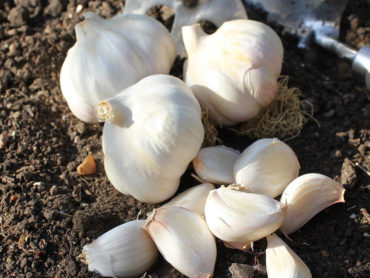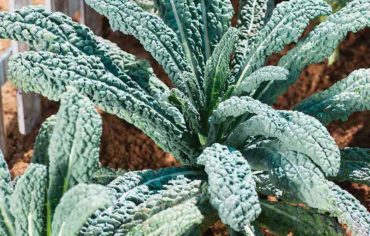Cabbage is one of the most versatile vegetables on the allotment. From crispy coleslaws to sizzling stir fries and hearty stews, there are endless ways to put this classic crop to good use. And, depending on the varieties you choose, you could be harvesting these leafy greens all year round. Here, experienced allotment grower Lee Senior shares practical advice on how to grow cabbages from seed.
Want to give it a go? Browse our full range of cabbage seeds.
How to choose the best cabbage varieties to grow
Cabbage comes in green, red and white, and there are different varieties for each season. Green is the most popular, while red cabbage is different to the others and is mainly grown over the summer months in the UK. With a little planning and successional sowing, it’s possible to be self-sufficient in cabbages for twelve months of the year. However, if space is limited, just focus on growing your favourite type.
Cabbages are grouped by their harvest times:
- Spring cabbages are sown in late summer during July and August. They tend to have pointed hearts but there are round-headed varieties too. They overwinter on your allotment (usually without protection) until harvesting in April and May, occupying the ground for up to 9 months. My favourite spring cabbage is F1 ‘Winterjewel’ – a tough overwintering pointed cabbage that doubles up for use as spring greens, but also forms a loose heart.
- Summer cabbages are sown in early spring and can be round-headed or pointed. The popular pointed types are quicker to mature and are a good choice for the first cabbage sowings of the new year. My favourite summer variety is the ultra-reliable ‘Greyhound’. The name is a clue as to how fast it grows when happy! This fine-tasting cabbage has a tight but relatively small pointed head that is ideal for using in one meal, reducing waste. It can be sown over a long season from February through to the end of June, with later sowings producing very fine cabbages in early autumn. Another favourite is ‘Golden Acre Primo’. I first grew this medium-sized round head variety as a student back in the 1990s and I’ve been growing it ever since. It’s ultra-reliable, has good flavour and is a no-frills cabbage that just gets on with the job!
- Autumn cabbages are sown in late spring until late May. They can be harvested between mid-August and early-December providing much needed continuity between the last of the summer harvest and the winter-cropping varieties. I really like F1 ‘Kilazol’ for autumn use. This is a white round-head type which can be sown between March and May and is ready for harvest between September and late November. In fertile soil it produces good-sized heads, from 1.5-2.5kg. The plants stand well when mature before they bolt and also store well in the fridge. This storing capability is not to be underestimated, as it can help avoid a glut when late-summer varieties mature. Finally, if all of the above isn’t enough, ‘Kilazol’ has excellent clubroot resistance too!
- Winter cabbages are sown during late May and early June and are much slower growing. They are very resistant to cold weather and store in the ground remarkably well before harvesting. They also store well for a number of weeks in a fridge or cellar or garage. Most varieties are ready from November through to early April, providing fresh food at a time when other things are in short supply.
- If red cabbage is your thing, then my varieties of choice are ‘Pretino’ and the better-known ‘Red Drumhead’. Red cabbage is not generally as hardy as other types, but ‘Red Drumhead’ can be overwintered in a cold frame from an August sowing and planted out in March. Red varieties store well for several weeks when harvested, either in a fridge, cellar or cold outbuilding.
How to sow cabbage seeds
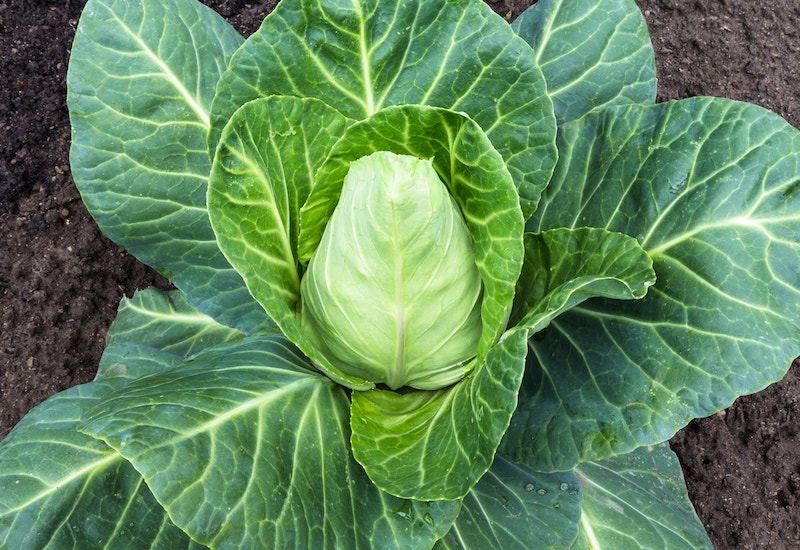
Image: Cabbage ‘Greyhound’ from Suttons
Cabbage seeds germinate in temperatures between 10C (50F) and 18C (64F) making them ideal for sowing early in the season. Summer cabbages can be sown as early as the beginning of February in a heated propagator or a warm windowsill. Here’s how:
- Sow the seed in trays of compost and very lightly cover with compost or perlite.
- As soon as germination has taken place, remove the seedlings from the propagator or windowsill and put them in an unheated greenhouse or cold frame to reduce the risk of them becoming leggy. A cold frame that is not in full sun all day is ideal.
- Transplant the seedlings into small 7.5cm (3 inch) pots when they gain their true leaves.
- Protect the seedlings from too much direct sunlight and heat while under glass. The young plants can become scorched or damaged by too much sunshine.
- Grow them on till they have 4-6 true leaves and a strong root system.
- Harden them off before they become too pot bound.
From April until late July, cabbage seeds can be sown directly outside into a finely raked, prepared seedbed.
Make a shallow seed drill 1.5cm deep and add a thin layer of multi-purpose compost before sowing the seed on top. Cover with more compost or fine soil and gently firm. Ensure the drill is moist before sowing, pre-watering it if necessary. This method frees up vital space in the greenhouse and is a better option than under glass as temperatures rise. It also means you won’t need to harden off your plants, and they can be transplanted straight into their final growing positions when they’re ready.
When and where to plant out cabbages
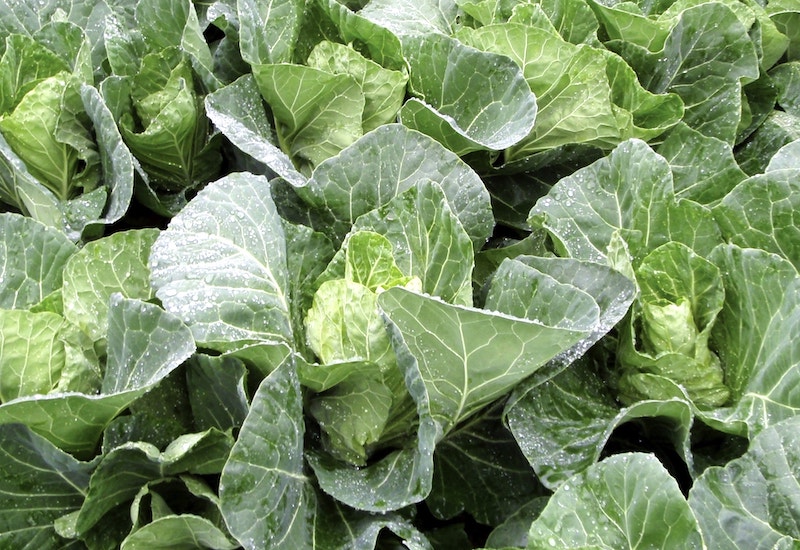
Image: Cabbage F1 ‘Winterjewel’ from Suttons
Plant out your summer cabbages firmly into soil containing plenty of well rotted organic matter. Choose a sunny location away from fences and hedges, avoiding heavy shade. Cover the plants with anti-butterfly netting to defeat cabbage white butterflies and pigeons.
Raised beds and open ground both work well, with raised beds being ideal for early summer types. I usually transplant glasshouse or coldframe-grown plants at the end of April or early May. There’s no need to protect from frost, but fleece may come in handy for protection from cold winds or low temperatures.
Planting distances vary according to the cabbage type and time of year:
- Summer pointed varieties require a distance of around 40cm (16 inches) between plants, a little less if you’re growing for greens. Round-headed varieties respond to slightly more generous spacings. As a rough guide, I also try to leave a minimum of 50cm (20 inches) between rows. This allows good access between rows and extra space for hoops or a frame to support netting.
- Overwintering cabbages need plenty of space to reach a good-sized heart. They occupy the ground for between 14-20 weeks depending on the variety and standing time. The spacings between the plants can affect the size of the heads and pointed varieties can be planted a little closer than round head types.
- I’ve also grown pointed cabbages successfully in large containers over the years. This reduces the risk of clubroot as the plants are grown in compost rather than garden soil. A mix of homemade compost, proprietary compost and leaf mould works very well in containers. They need regular watering and the heads are likely to be a little smaller, but containers work well if you’re short of space.
How to care for cabbages
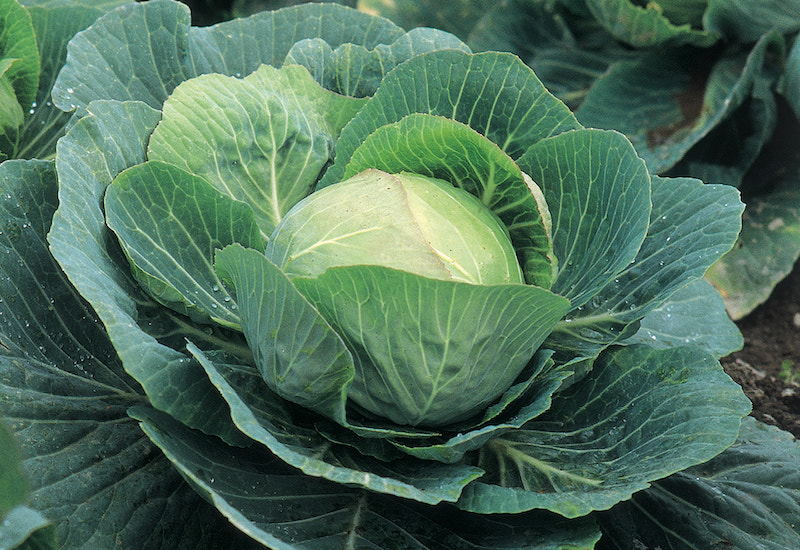
Image: Cabbage F1 ‘Kilazol’ from Suttons (© T&M)
Cabbages prefer soil with a PH of around 7 (neutral) or a little on the alkaline side of neutral. Acidic soils are not suitable. Plant your cabbages out firmly as they like good anchorage. Firm planting can also deter the cabbage root fly from laying eggs. The resultant larvae are one of the main pests of cabbages and brassicas. Another deterrent for this pest is to place a collar around the stem of the plants during the planting out stage.
Cabbages are easy to grow if your soil is rich in well-rotted organic matter, but they need plenty of water during hot, dry spells. Water your transplants liberally to help them establish and feed cabbage plants with a slow-acting nitrogen feed if your soil is poor.
The most common pest comes from the air in the form of cabbage white butterflies whose eggs hatch into the voracious caterpillars that can strip a plant bare within a matter of hours. Use fine anti-butterfly netting and completely enclose the plants to prevent eggs being laid on the leaves. Alternatively, hand pick any caterpillars as seen and destroy clusters of eggs visible on the underside of leaves before they can hatch.
Another aerial assault comes in the form of pigeons. They will strip the leaves, leaving just the stalks and midrib. Plants can recover, but there’s a loss of vigour and any resulting heart is likely to be smaller in size. Pigeons can easily be defeated by netting.
Clubroot is the main disease to look out for with all brassicas. This destructive and contagious fungal disease renders the plants useless. Growth is sickly and stunted and the plants wilt badly. Underground the roots are malformed and swollen and severely damaged. One way to try and deal with clubroot is to raise the PH of the soil with lime if necessary. This reduces the risk of the plants succumbing to the disease. Growing the plants in compost and transplanting them outside also helps. The good news is that there is an increasing choice of clubroot-resistant varieties – a key weapon in our armoury.
Slugs are often drawn to cabbages, but especially at planting out time and during wetter spells. Use your preferred method to deal with them.
How to harvest and store cabbages
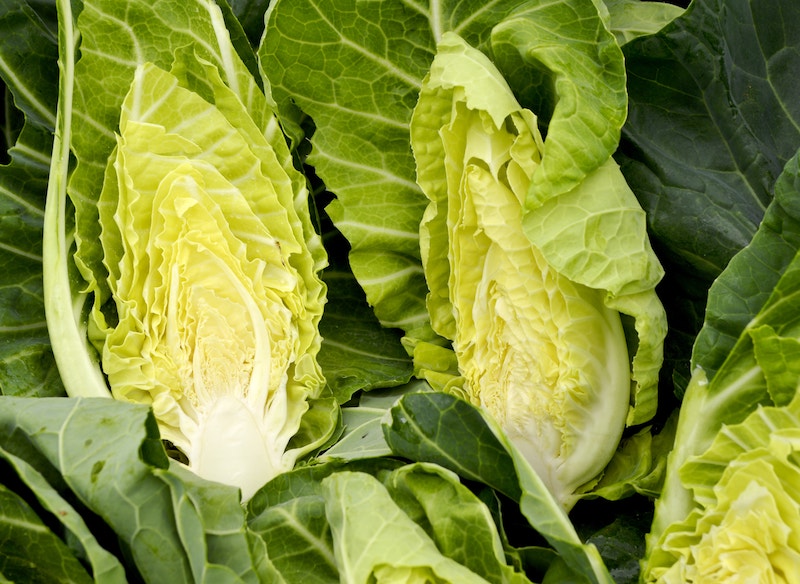
Image: Spring Green F1 ‘Summer Jewel’ from Suttons
Harvest cabbages using a sharp knife by cutting them from the stump. Alternatively, pull them up and snap off the stump by hand or by cutting with a sharp spade.
Sometimes the stump will regrow and produce a secondary smaller head if you leave around 12-15cms length on it. To further encourage this, make a cross in the top of the stump and give it a good watering if conditions are dry.
I remove the outer leaves of harvested cabbages if I’m eating them soon, and add them to the compost heap. If slugs or caterpillar eggs are hiding, the outer leaves are where they’ll be.
We hope we’ve inspired you to try growing your own cabbages from seed. Find more of Lee’s practical, hands-on, vegetable growing advice over at his monthly allotment pages
Main image: Cabbage F1 ‘Sunta’ from Suttons
Last Updated on July 29, 2025 by Suttons Horticultural Team



